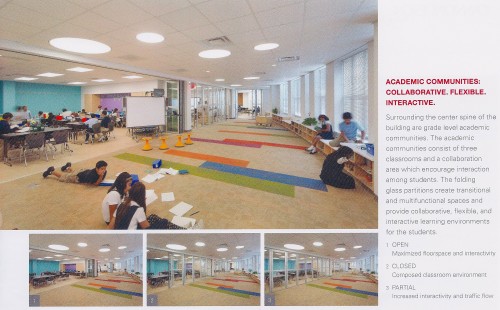Louise and I spent two scintillating days in Denver last week at the Second Annual Green Schools Conference, a convergence of 1,500 educators, architects, engineers, businesspeople, chefs, farmers, and many NGO-er’s...oh, yeah, and Arnie Duncan (who gave a keynote address to all on Wednesday morning). Among the many connections I made, I renewed an acquaintance I’d made with Trung Le several years ago at a school architecture symposium convened by Reggio Children in Reggio Emilia, Italy. Trung is a principal at Cannon Design. Since I’d met him he had been a key contributor in the writing of The Third Teacher (Abrams 2010). I’d read the book immediately upon its release and was taken by the synchronicity with my own experience and thinking.
To begin to explain, I’ll point to a wonderful project Cannon has completed, Booker T. Washington STEM Academy in Champaign, IL.
I’ve scanned the photos above from a brochure Cannon Design composed. In the photo you see interior classrooms that open to an “hallway” space. There are many architectural patterns manifest here that reinforce 21st C. pedagogy, including:
- differentiated spaces for differentiated learning
- varied spaces for collaborative, interactive learning
- natural light for improved learning
- low energy lighting for energy savings and sustainability
- flexible walls for flexible group arrangements
- glass walls for transparency and interconnectedness
- soft carpet floors for different learning styles
- carpet floors and acoustical tile ceiling for auditory sensibility
In their book, Trung Le and his partners outline in graphically dynamic and simple, straight forward terms, 79 ways you can use design to transform teaching and learning. If you are involved in changing the spaces in your school, this is a must read.

